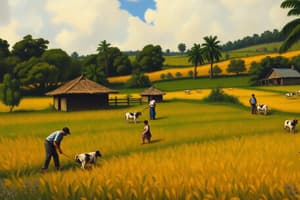Podcast
Questions and Answers
What is land/agrarian reform?
What is land/agrarian reform?
Land reform refers to programs and measures by the government to control and use land for community benefit.
What are the goals of land reform?
What are the goals of land reform?
- Concentrate landholdings
- Increase productivity (correct)
- Takeover land without compensation
- Change agrarian structure (correct)
Land reform includes measures to modernize agricultural practices.
Land reform includes measures to modernize agricultural practices.
True (A)
Before the Spaniards came to the Philippines, the Filipino social system was ______.
Before the Spaniards came to the Philippines, the Filipino social system was ______.
The encomienda system benefited the encomenderos more than the natives.
The encomienda system benefited the encomenderos more than the natives.
What influenced the social and economic life of the nation during the colonization period?
What influenced the social and economic life of the nation during the colonization period?
What did the encomenderos become after the system deteriorated?
What did the encomenderos become after the system deteriorated?
What were encomiendas during the Spanish colonial period?
What were encomiendas during the Spanish colonial period?
Study Notes
Land and Agrarian Reform in the Philippines
- Land Reform is a government measure that aims to improve land control & use, bringing benefits to the entire community.
- This often involves the government acquiring land from large landowners (with compensation) and transferring it to small farmers or landless workers.
- Agrarian Reform goes further than land reform, it aims to modernize agricultural practices and improve living conditions of the entire agrarian community.
- This includes support for agricultural education, the establishment of cooperatives, agricultural credit, and development of agro-based industries.
History of Land Reform in the Philippines
Pre-Spanish Era
- Feudal Social System: Similar to medieval Europe, a warrior class (bound to warlords) lived off the labor of serfs and slaves.
- Social Hierarchy: Datus (chiefs) were the nobility, followed by timawas (freemen), aliping namamahay (serfs), and aliping saguiguilid (slaves).
- Land Ownership: Freeborn individuals didn't pay tributes, but were bound to follow datus in war, contributing their own weapons and labor for building and farming.
- Serfdom: Serfs worked for a master, often a datu, sharing the harvest equally. They owned their own houses and could pass them down.
- Slavery: Slaves served their masters both at home and on the farm, receiving some share of the harvest, but could be sold.
Spanish Era (1565-1898)
- Encomienda System: Lands were divided and granted to Spanish settlers or soldiers, encouraging settlement and rewarding service to the Crown.
- Encomienderos: These grant holders were obligated to defend the encomienda, maintain order, and support missionaries. In return, they gained the right to collect tributes from natives.
- Abuse of Power: The system evolved into the encomenderos collecting land rent, and natives became tenants, leading to the origin of hacenderos (landowners).
- Colonial Government: The Spanish colonial government replaced the datus, with the cabeza de barangay (village head) becoming a figurehead while estate proprietors held real power.
Four Classes of Estate Proprietors During the Spanish Period:
- Religious Orders: Dominican and Augustinian.
- Spanish Peninsulares: Born in Spain.
- Criollos and Mestizos: Criollos were Spanish-born in the Philippines, while mestizos were of mixed Spanish and Filipino ancestry.
- Filipinos: Land ownership, primarily concentrated among the first three groups, left Filipinos with limited access to land.
Studying That Suits You
Use AI to generate personalized quizzes and flashcards to suit your learning preferences.
Related Documents
Description
This quiz explores the concepts of land and agrarian reform in the Philippines, detailing its historical context and objectives. It covers the transition from feudal systems to modern agricultural practices aimed at benefiting small farmers and landless workers. Understand how these reforms impact communities and enhance agricultural productivity.




